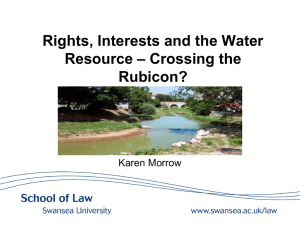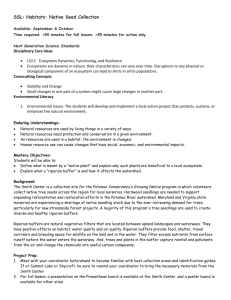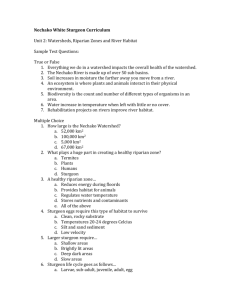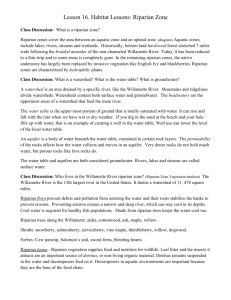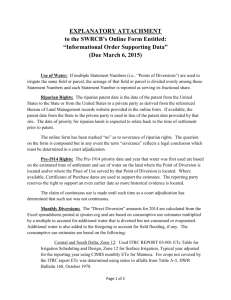Rip Roarn` Fun - Find out more
advertisement
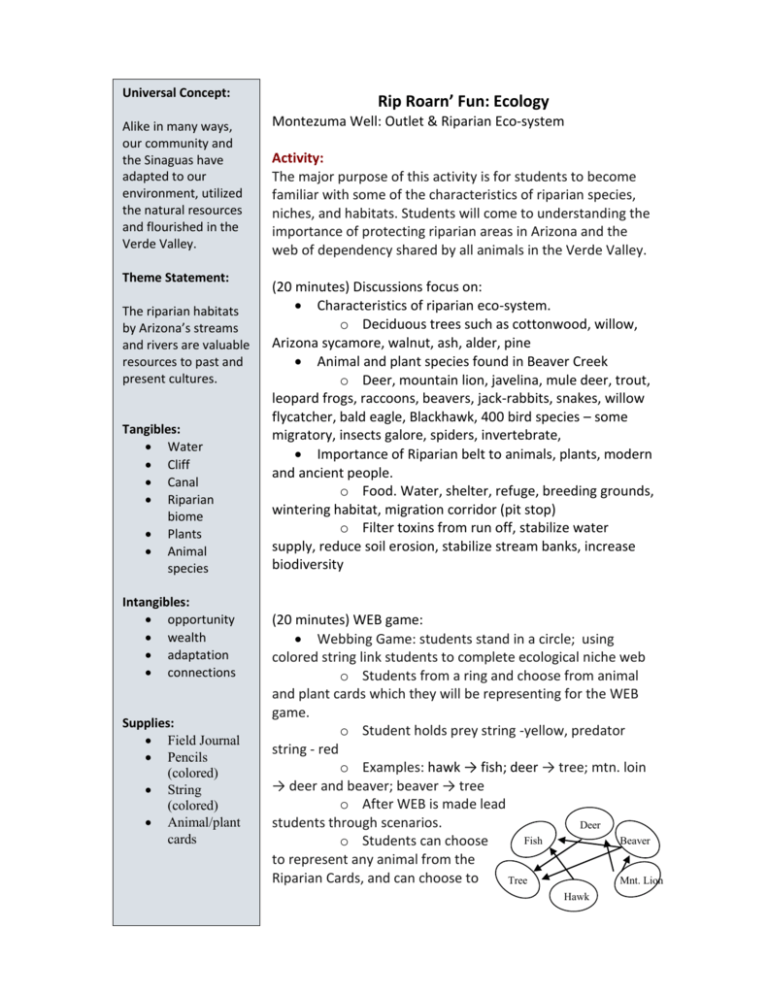
Universal Concept: Alike in many ways, our community and the Sinaguas have adapted to our environment, utilized the natural resources and flourished in the Verde Valley. Theme Statement: The riparian habitats by Arizona’s streams and rivers are valuable resources to past and present cultures. Tangibles: Water Cliff Canal Riparian biome Plants Animal species Intangibles: opportunity wealth adaptation connections Supplies: Field Journal Pencils (colored) String (colored) Animal/plant cards Rip Roarn’ Fun: Ecology Montezuma Well: Outlet & Riparian Eco-system Activity: The major purpose of this activity is for students to become familiar with some of the characteristics of riparian species, niches, and habitats. Students will come to understanding the importance of protecting riparian areas in Arizona and the web of dependency shared by all animals in the Verde Valley. (20 minutes) Discussions focus on: Characteristics of riparian eco-system. o Deciduous trees such as cottonwood, willow, Arizona sycamore, walnut, ash, alder, pine Animal and plant species found in Beaver Creek o Deer, mountain lion, javelina, mule deer, trout, leopard frogs, raccoons, beavers, jack-rabbits, snakes, willow flycatcher, bald eagle, Blackhawk, 400 bird species – some migratory, insects galore, spiders, invertebrate, Importance of Riparian belt to animals, plants, modern and ancient people. o Food. Water, shelter, refuge, breeding grounds, wintering habitat, migration corridor (pit stop) o Filter toxins from run off, stabilize water supply, reduce soil erosion, stabilize stream banks, increase biodiversity (20 minutes) WEB game: Webbing Game: students stand in a circle; using colored string link students to complete ecological niche web o Students from a ring and choose from animal and plant cards which they will be representing for the WEB game. o Student holds prey string -yellow, predator string - red o Examples: hawk → fish; deer → tree; mtn. loin → deer and beaver; beaver → tree o After WEB is made lead students through scenarios. Deer Fish Beaver o Students can choose to represent any animal from the Riparian Cards, and can choose to Tree Mnt. Lion Hawk represent ancient Sinagua, or modern farmer. Scenario One: The riparian area is healthy. The winder storms came and the river flows from the snow melt. Trees are in bloom and growing. [Trees should give a tug of string.] The insects are hatching in the spring sun and eating plants and pollinating flowers. [Insects should give a small tug.] The spring sun grows warm and the river is in it’s majesty in the heat of the summer. Many animals use the area for water, shade and home. Beaver builds his damn from the cottonwood and sycamore trees. [Beaver tugs.] Ask ‘raccoon’ to tug gently on predator string. Who else felt that? Are we connected? Do we each have a special job?Mountain lion hunts deer at the edge of the trees, knowing it will come and drink at the cool river. [Mountain Lion tugs.] o Continue the story giving examples of a healthy ecosystem. Each animal or plant being represented should get to tug their strings. Scenario Two: The Riparian area is in danger. Developers are building a dam north of Montezuma Well. They predict that the water flow will be reduced by half and the water from the new dam will be used in larger cities. In the spring after the dam has been built many trees die because there is not enough water to sustain so many. [Trees drop their string.] When the trees die many birds loose their homes. [Birds tug.] The migrating birds that once stopped at Montezuma Well are fewer than before because of the trees and water. [Birds drop some strings.] The deer that once visited the river have migrated north and east to more abundant water supplies. [Some deer drop strings.] Farmers are no longer able to irrigate their farms and are forced to sell their land and leave. [Farmers drop string.] o Continue scenario giving appropriate examples of possible outcomes resulting in a dam of Beaver Creek. All students should get a change to tug or drop string. Scenario Three: Forest fire affects the area. Scenario Four: Severe Pollution affects the water or air. Identify, if possible, examples of changes that would have positive consequences for one or more kinds of animals. For example, severe northern storm season would increase the water volume in spring and would affect the aquatic dwellers— fish, frogs, mosquitoes, etc. Ask the students to discuss the possible effects on the remaining animals and plants in the area. Repeat with a different change; e.g. fire development, damming, stream diversion. Investigate what kind of repairs can be done to riparian zones after extensive damage has occurred. If it seems useful and appropriate, explore the possibility of a riparian restoration team working in your community to reinstate the health of any riparian areas that have been degraded. (20 minutes) Field observations: Campers All Ages: Choose one animal and identify its ecological niche in the system. Identify “occupation” – what does it do? Eat? And “address” – home. Field Journal Campers All Ages: Students make a detailed sketch of their niche animal. Note adaptations (physical and behavioral) that allow them to survive in their habitat. Label parts. Field Journal Campers age 12 – 15: Students construct a model of the WEB Game just demonstrated and compare effects of one scenario. Students could also sketch ecosystem including biotic and abiotic components. Include the water cycle, carbon dioxide/oxygen cycle, nutrient cycles. Use arrows to show the flow of energy and materials. Field Journal Alternative Activity: Borrow from Ranger Wagner the ‘Crime Scene’ tarp. Additional supplies: pelts, skulls, tracks, scat Discuss with campers that in nature, as in the city, we can hypothesize or guess what happened in an area. Campers should discuss the types of tracks, directions, possible and possible scenarios. This activity is included in the Jr. Ranger Journal Book. Background: Arizona’s desert rivers and streams are immeasurably valuable resources. Only five extensive stands of this rare forest type remain in Arizona. As much as 90 percent of the resident wildlife in Arizona depends on riparian areas such as Beaver Creek for their very survival. The rare water is home to many animals that are adapted to live near water. The animals that live in a riparian area are adapted to the distinct characteristics of the area including higher humidity, abundance of water, cooler temperatures, and diversity of animals. Beaver Creek is fed from snowmelt from northern mountains. It is representative of the most common riparian community in the American Southwest, and is a globally endangered community, which is found in fewer than 20 places in the world. The water supply from the Well and Beaver Creek is enough to supply human, animal and plant life. Riparian areas provide food, water, shelter, refuge, breeding grounds, wintering habitat, and migration corridors for an amazing diversity of birds, mammals, reptiles, fishes, and amphibians. Trees found here are primarily cottonwood, willow, and sycamore, with scattered stands of walnut, ash, and alder. The Sinagua used the Arizona Sycamore for support beams, ceiling and roof construction in their pueblos and pit-houses. Deer, mountain lion, javelina, mule deer, trout, leopard frogs, raccoons, beavers, and other animals, including threatened and endangered species, use riparian corridors like this one as they move across the desert areas and travel from low-elevations to high-elevation habitats. At least 400 different bird species have been found in the Verde River/ Beaver Creek riparian corridor. Many migrating birds, such as the summer tanager and hooded oriole, use this and other such corridors to migrate to Central and South America every winter. Several endangered, threatened, and candidate Arizona species, including the Southwestern willow flycatcher, bald eagle, and common Blackhawk, depend upon the corridor to help sustain their populations. Scarce Southwestern river ways like Beaver Creek are home to more species of breeding birds than anywhere in the world outside of tropical rainforests, and are among the highest numbers reported in North America. Riparian habitats improve water quality by filtering out toxic compounds; stabilize water supplies and moderate floods; reduce soil erosion, and stabilize stream banks; increase biodiversity by providing plant and animal habitat. Dozens of different animals and plants, biotics, live in, around, above, and below the riparian habitat. Abiotics, or non-living components, affect the diversity and adaptations made by animals and plants in riparian areas. Many animals that live here cannot survive without the special conditions that the riparian zone provides. Riparian areas often provide more shade, higher humidity, and more diversity in animals and plants than surrounding areas. The width of a riparian area depends on the amount of available water, soil types, minerals, water table, geologic structures, and many other factors. Riparian habitats are both aquatic (water) and terrestrial (earth), and are characterized by wide diversity in life forms. Each animal in a community has a role — an “occupation.” This role is called its ecological niche. Have the students identify the basic niches found in all environments: producers, consumers, and decomposers. The niche includes such things as the animal’s preferences for food, shelter, and space. If niche is an animal’s “occupation,” then habitat is its “address.” In such settings, animals favoring riparian habitats fill niches. For example, frogs are commonly found in areas of calm waters in riparian zones. Frogs are predators, once they mature beyond their algae-eating tadpole stages. They need moisture, sunlight, and grasses or other vegetative shelter. Their eggs must be deposited in water that is permanent enough to allow a year-long period to hatch, grow into gilled tadpoles, and finally transform into insect-eating, air-breathing frogs. Fish and wading birds prey on both. Raccoons, foxes, and other animals eat tadpoles and frogs, a well as fish. It is the interrelatedness of all these “occupations” and “addresses” that characterize the uniqueness and beauty of riparian zones. Riparian areas are easily affected by natural and human-caused changes. During the last 100 years, over 95 percent of the riparian habitat in Arizona has been disturbed, lost or significantly altered due to human impacts including the pumping of ground water, which drains the water from underlying aquifers; land use practices such as grazing, farming, and recreational uses altering the vegetation and surface water supply; the building of dams and straightening of river courses (channelization); and the introduction of exotic plant species such as salt cedar. The last is especially damaging, because the proliferation of salt cedar and other exotics discourages the germination of highly significant native plants like cottonwood and sycamore. Spring flooding and flash floods dramatically affect vegetation and wildlife. Excessive use of riparian areas by humans, livestock, and wildlife can result in destruction of riparian vegetation and destabilization of the stream or riverbank, causing increased rates of erosion. In arid areas of the west, whole stream flows have been diverted from original channels to provide water for farming and livestock use. Development and recreational pressures also threaten this unique habitat. Riparian zones are fragile and can be destroyed easily. VOCABULARY: Abiotic: the non-living parts of the ecosystem, meaning air, light, and water and soil components of an ecosystem. Biotic: the living parts of the ecosystem, meaning all the plant and animal components of an ecosystem. Ways humans are using or changing the stream and the land surrounding the stream. Consumer: an organism that feeds off another organism. All animals can be sub-divided into prey and preditor. Decomposer: organisms that feed from decomposing organic matter. Typical detritivorous animals include millipedes, woodlice, dung flies, many terrestrial worms, and burying beetles. “Bottom feeders”, “garbage men” Disturbed riparian ecosystem: a disturbed riparian ecosystem has been damaged. Most of the damage is done by people: logging, roads, fences, discarded trash, fires, etc. Ecosystem: all living and non-living things in an area of any size, all linked together by energy and nutrient flow. Erosion: the process of weathering or wearing away of soil by wind or water. Habitat: place where a living thing is naturally found. The salmon’s habitat is in freshwater streams and the ocean. Macroinvertebrates: small animals, such as insects and worms. An invertebrate is an animal that does not have a backbone (vertebrae) Natural riparian ecosystem: includes all the abiotic and biotic things listed. What is naturally there, as compared man-made, constructed, housing developments, etc. Oxygen: a gas without color, taste or odor that forms about one-fifth of the air we breathe. Animals and plants cannot live without oxygen. Pollution: anything that dirties an environment or habitat, such as farm animal waste, chemicals, oil spills, etc. Water pollution would ‘dirty’ the salmon’s habitat. Producer: Primary producers are those organisms in an ecosystem that produce biomass from inorganic compounds (autotrophs).plants and organic organisms in an eco-system Restored riparian ecosystem: people can restore the riparian ecosystem by replanting trees, cleaning up streams, keeping farm animals away from streams, controlling building of homes, preventing oil and other chemicals from getting into the water. Riffles: a rocky area or sandbar just below the surface of a stream, causing the water to become choppy. Riparian: a term used to define the green ribbon of trees and plants that border either side of a stream, the stream itself, and includes all the abiotic (non-living) and biotic (living) things in the area. To waste, to destroy our natural resources, to skin and exhaust the land instead of using it so as to increase its usefulness, will result in undermining in the days of our children the very prosperity which we thought by right to hand down to them amplified and developed. — Theodore Roosevelt References: NPS, DOI. 2005. Educator’s Guide: Montezuma Castle National Monument Tuzigoot National Monument. NPS, DOI. Wikipedia contributors, 'Riparian zone', Wikipedia, The Free Encyclopedia, 17 June 2009, 17:53 UTC, <http://en.wikipedia.org/w/index.php?title=Riparian_zone&oldid=296994841> [accessed 17 June 2009]





